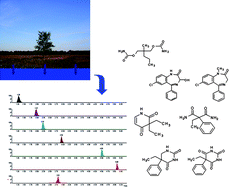An analytical method was developed and validated for the simultaneous determination of six psychoactive compounds (meprobamate, primidone, phenobarbital, pyrithyldione, diazepam, and oxazepam) and a metabolite of primidone (phenylethylmalonamide) in environmental water samples. The method involves pre-concentration and clean-up by solid phase extraction (SPE) followed by ultrahigh-performance liquid chromatography-tandem mass spectrometry (UHPLC-MS/MS), using electrospray ionization (ESI) in both positive and negative modes. Limits of quantification (LOQs) were between 0.02 and 0.03 µg L−1 in groundwater and between 0.1 and 0.15 µg L−1 in wastewater. With a few exceptions, relative recoveries of the analytes exceeded 80%. The described method was used to analyze the selected psychoactive drugs in groundwater that had been affected by sewage irrigation for several decades ago and treated and untreated wastewater from Berlin (Germany). Highest values were found in groundwater with concentrations reaching up to 1.35 µg L−1 in the case of phenobarbital.

You have access to this article
 Please wait while we load your content...
Something went wrong. Try again?
Please wait while we load your content...
Something went wrong. Try again?


 Please wait while we load your content...
Please wait while we load your content...